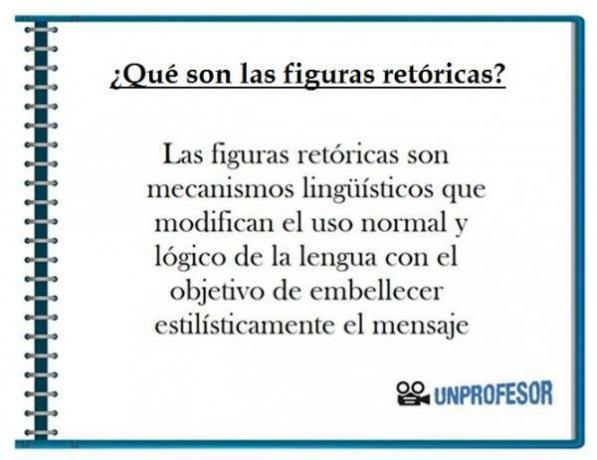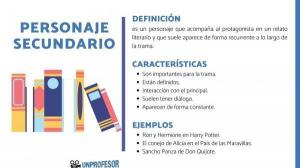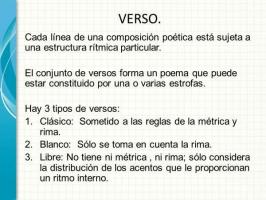What are figures of speech

Rhetorical figures, also called literary figures, stylistic devices, rhetorical devices or literary devices, are mechanisms linguistics that modify the normal and logical use of the language with the aim of stylistically embellishing the message. They are characterized by the originality that they contribute to the content of the statement, intensifying its meaning, and are used both in literary language and in colloquial, advertising, journalistic language and even in the language political. Keep reading this lesson from a Teacher where you will learn what are rhetorical figures and you will see different examples.
Index
- Asyndeton and polysyndeton
- Antithesis or contrast
- Alliteration
- Ellipse
- Hyperbaton and hyperbole
- Metaphor
- Onomatopoeia
- Paradox
- Personification or prosopopoeia
- Reiteration or anaphora
Asyndeton and polysyndeton.
Asyndeton is a literary figure that consists of the omission of conjunctions of a text in order to facilitate the vividness and dynamism of what you want to express. Instead of the conjunctions, commas appear that fulfill the function of links, as in the following verses by Lope de Vega:
Pass out, dare, be furious
rough, tender, liberal, elusive,
encouraged, deadly, deceased, alive
loyal, traitorous, cowardly and courageous.
For its part, the polysyndeton is the opposite figure to asyndeton, since it is characterized by the excessive use of conjunctions with the aim of slowing down and providing greater solemnity to the text, as Juan Ramón Jiménez does:
There is a palace and a river and
a lake and an old bridge,
and fountains with moss and grass
high and quiet... a silence.
Antithesis or contrast.
The antithesis or contrast is the opposition of one word or statement to another whose meaning is the opposite (white - black, love - hate, life - death), so that both ideas or concepts are opposed:
Children go for the sun
and the girls by the moon.
In this text by José Agustín Goytisolo we can observe the antithesis between "boys" and "girls" as well as between the words "sun" and "moon".
Alliteration.
Alliteration is the repetition of two or more of the same sounds or very similar to each other in several correlative words of the same sentence, verse or stanza. You've probably heard (and maybe tried to say out loud) this well-known tongue twister:
Three sad tigers ate wheat in a wheat field. One tiger, two tigers, three tigers.
The difficulty of the tongue twister lies in the excessive repetition of the sounds "t" and "r" caused by this stylistic device.
Ellipse.
Ellipsis Consists of the intentional omission of a linguistic element within a sentence or speech whose meaning can be inferred from the context. The ellipsis brings speed and energy to the text:
For a look, a world;
for a smile, a sky;
for a kiss... I do not know
what would I give you for a kiss!
In this famous rhyme by Gustavo Adolfo Bécquer we observe how the verb is elided in the first three verses and, thanks to the last one, we can understand what the meaning of the previous ones is.
Hyperbaton and hyperbole.
The hyperbaton is the alteration of the grammatical and logical order of the elements that make up the sentence. In addition to literary texts, this literary figure is very present in advertising and the press, as well as in everyday language, as can be seen in the following examples: Bye thank you when the expected would be "Thank God" or Sleeping is already instead of "He's already sleeping".
For its part, hyperbole consists of exaggerating reality in an extreme way to give the text greater intensity and effect. Like the hyperbaton, it is a very frequent stylistic device in oral language. You have probably heard the following hyperbolic expressions more than once: I'm hungry I'm dying, I've told you a million times or I love you to infinity and beyond.
Metaphor.
He is perhaps one of the most recurrent literary figures of all time. The metaphor is based on the identification of one object with another by virtue of the similarity between the two. It is a complex linguistic mechanism that starts from the comparison between a real term and another evoked or imaginary one that has a certain resemblance to the first. Both in literature and in spoken language we constantly use metaphors: Time is money, Young people are the future, It is in the prime of life or Surfing the Internet are common phrases in our day to day and are based on a metaphor.
Onomatopoeia.
Onomatopoeia is the formation of a word from the imitation of sound which it designates, usually it is sounds of nature (Glu Glu) or animals (Kikiriqui), although there are also many onomatopoeias based on artificial noises such as Boom! Crash! Ring, ring! or TIC Tac.
Paradox.
The paradox is the union of two opposing ideas. In this sense, it resembles the antithesis but goes further, since the paradox brings together both in the same thought. contrary ideas to express a deep feeling, such as that transmitted by Saint Teresa of Jesus in the verses that follow:
I live without living in my
and so high life I hope
that I die because I do not die.
Personification or prosopopeia.
As the name suggests, the personificationon is based on attribute human characteristics to animal or inanimate beings. It is an aesthetic resource widely used in fables and legends, where the protagonists are animals that behave as if they were people; they speak, think, lie, reason... etc.
This literary figure is divided into three subtypes:
- Animation: Assign animate qualities to inanimate beings: Only the white laughter of the stars will be heard / chasing the shadows on all roads (Leon Felipe).
- Animalization: attributes irrational behaviors to (rational) human beings: The killer stalked his victim like a vulture.
- Objectification: applying characteristics of the inanimate world to living beings: He was a blowpipe clergyman, long only at the waist, a small head, his eyes fixed on the nape of the neck, that it seemed that he was looking through basins, so sunken and dark, that his was a good place for a merchant shop (Francisco de Quevedo).
Reiteration or anaphora.
The reiteration or anaphora is the repetition of words at the beginning of a verse or sentences similar to each other to highlight an idea or thought within the speech as a whole, as in the following text by Miguel Hernández:
Hit the blade, mill
until the wheat snows
hit the stone, water
until I make her meek
give the mill, air
to the endless
hit the air, goatherd
until it whistles tender.
If you want to read more articles similar to What are figures of speech - With examples!, we recommend that you enter our category of Literary concepts.

![What is the VIA NOTEBOOK - [with EXAMPLES and EXERCISES solved]](/f/95e27f73e2fa19f1267ea034063448b5.jpg?width=300&height=200)

